






- Total
- General
- Arts
- Book
- Culture
- Economy
- Essay
- Fun/Joke
- History
- Hobbies
- Info
- Life
- Medical
- Movie
- Music
- Nature
- News
- Notice
- Opinion
- Philosophy
- Photo
- Poem
- Politics
- Science
- Sports
- Travel
|
내가 애호하는 구절을 영어로는 My favorite passages라고 불러도보았다. 테르모필레 전투의 역사적 개요: The Battle of Thermopylae (/θərˈmɒpɪliː/ thər-MOP-i-lee; Greek: Μάχη τῶν Θερμοπυλῶν, Máchē tōn Thermopylōn) was fought in 480 BC between the Achaemenid Persian Empire under Xerxes I and an alliance of Greek city-states led by Sparta under Leonidas I. Lasting over the course of three days, it was one of the most prominent battles of both the second Persian invasion of Greece and the wider Greco-Persian Wars. 라케다이몬 사람들에게 가서 전하라 여기에 그대들의 말을 따라 우리는 죽었노라고. 시모니테스 Epitaph of Simonides  Epitaph with Simonides' epigram A well-known epigram, usually attributed to Simonides, was engraved as an epitaph on a commemorative stone placed on top of the burial mound of the Spartans at Thermopylae. It is also the hill on which the last of them died. The original stone has not survived, but in 1955, the epitaph was engraved on a new stone. The text from Herodotus is: Ὦ ξεῖν', ἀγγέλλειν Λακεδαιμονίοις ὅτι τῇδε κείμεθα, τοῖς κείνων ῥήμασι πειθόμενοι. Ō ksein', angellein Lakedaimoniois hoti tēide keimetha, tois keinōn rhēmasi peithomenoi. O stranger, tell the Lacedaemonians that we lie here, obedient to their words. Herodotus says: Crown-wearing Achaemenid king killing a Greek hoplite. Impression from a cylinder seal, sculpted circa 500 BC–475 BC, at the time of Xerxes I. Metropolitan Museum of Art. 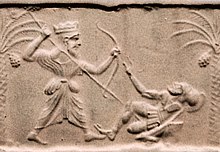 Here they defended themselves to the last, those who still had swords using them, and the others resisting with their hands and teeth IMAGES 1. 테르모필레 전투 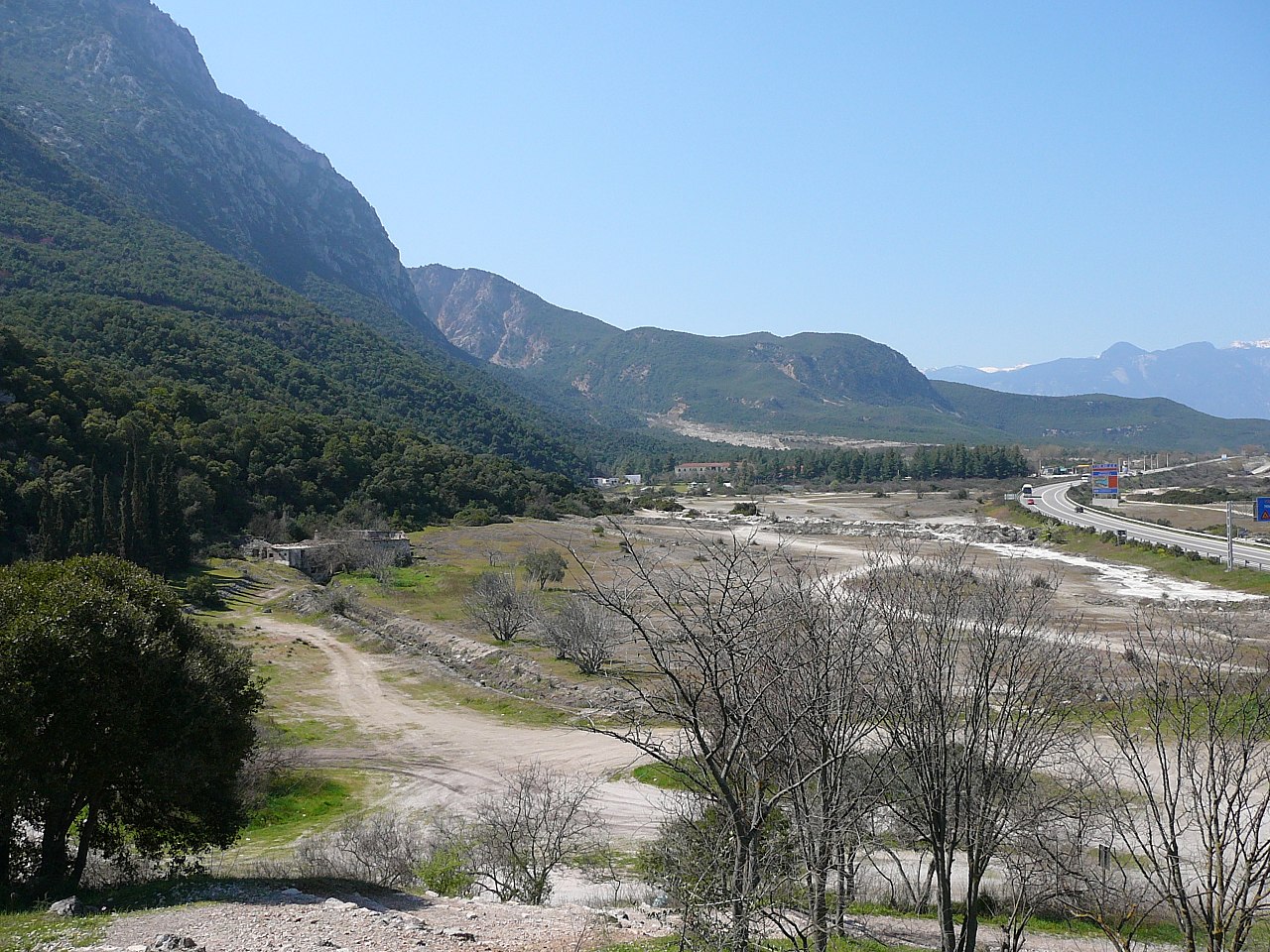 2. 페르시아 전쟁시기에 그리스 세계 전도 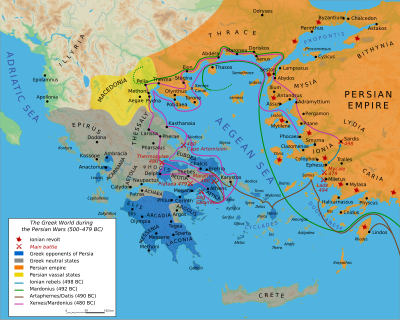 3. 그리스와 페르시아 군의 테르모필레와 아르테미시온 진군을 보여주는 지도 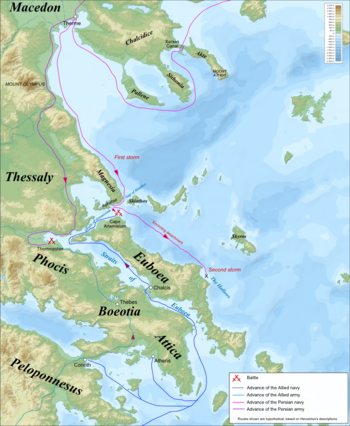 4. 테르모필레의 과거와 현재 지도  5. 페르세우스 프로젝트의 자료에 근거한 그리스 팔랑크스 병진 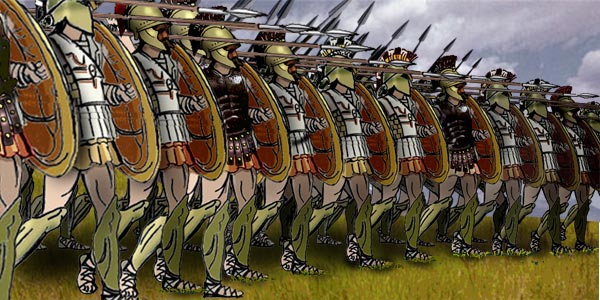 6. 테르모필레의 레오니다스, 자크루이 다비드, 1814년. 이 작품은 테르모필레 전투의 다양한 역사적, 전설적 요소를 함께 실은 작품이다.  7. 시모니데스 경구가 음각된 묘비  8. Battle of Thermopylae Youtube(14 min 52 sec) 9. Harvest of War 10. Battle of Thermopylae Simonides of Ceos A well-known epigram, usually attributed to Simonides, was engraved as an epitaph on a commemorative stone placed on top of the burial mound of the Spartans at Thermopylae. It is also the hill on which the last of them died.[71] The original stone has not survived, but in 1955, the epitaph was engraved on a new stone. The text from Herodotus is: Ὦ ξεῖν', ἀγγέλλειν Λακεδαιμονίοις ὅτι τῇδε κείμεθα, τοῖς κείνων ῥήμασι πειθόμενοι. Ō ksein', angellein Lakedaimoniois hoti tēide keimetha, tois keinōn rhēmasi peithomenoi. O stranger, tell the Lacedaemonians that we lie here, obedient to their words. The alternative ancient reading πειθόμενοι νομίμοις (peithomenoi nomίmois) for ῥήμασι πειθόμενοι (rhēmasi peithomenoi) substitutes "laws" (νόμοι) for "words". |
|
| Translation Go tell the Spartans, thou who passest by, That here, obedient to their laws, we lie. Stranger, tell the Spartans that we behaved. as they would wish us to, and are buried here. Stranger! To Sparta say, her faithful band Here lie in death, remembering her command. Stranger, report this word, we pray, to the Spartans, that lying Here in this spot we remain, faithfully keeping their laws. Stranger, bear this message to the Spartans, that we lie here obedient to their laws. Go tell the Spartans, stranger passing by, that here obedient to their laws we lie. Go, stranger, and to Lacedaemon tell That here, obeying her behests, we fell. Oh Stranger, tell the Spartans That we lie here obedient to their word Stranger, when you find us lying here, go tell the Spartans we obeyed their orders. Go tell the Spartans, passerby: That here, by Spartan law, we lie. 오! 나그네여! 스파르타 인에게 말해다오! 우리가 여기에 누웠다고, 약속을 지켰다고. |
Notes William Lisle BowlesGo tell the Spartans, thou who passest by, That here, obedient to their laws, we lie. William Golding Francis Hodgson None George Campbell Macaulay William Roger Paton Steven Pressfield George Rawlinson Cyril E. Robinson Aubrey de Sélincourt William Shepherd Hadas (1950) From the 1962 film The 300 Spartans From the 1977 film Go Tell the Spartans Frank Miller (1998; subsequently used in the 2007 film, 300) Kwan Ho Chung 2023 at Fort Lee, New Jersey |
|
The first line of the epigram was used as the title of the short story "Stranger, Bear Word to the Spartans We…" by German Nobel Prize laureate Heinrich Böll. A variant of the epigram is inscribed on the Polish Cemetery at Monte Cassino. John Ruskin expressed the importance of this ideal to Western civilization as follows: |
|
|
내가 애호하는 구절을 영어로는 My favorite passages라고 불러도보았다. 테르모필레
전투의 역사적 개요: The Battle of Thermopylae (/θərˈmɒpɪliː/ thər-MOP-i-lee; Greek: Μάχη τῶν Θερμοπυλῶν, Máchē tōn Thermopylōn) was fought in 480 BC between the Achaemenid Persian Empire under Xerxes I and an alliance of Greek city-states led by Sparta under Leonidas I. Lasting over the course of three days, it was one of the most prominent battles of both the second Persian invasion of Greece and the wider Greco-Persian Wars. 라케다이몬 사람들에게 가서 전하라 여기에 그대들의 말을 따라 우리는 죽었노라고. 시모니테스 Epitaph of Simonides  Epitaph with Simonides' epigram . A well-known epigram, usually attributed to Simonides, was engraved as an epitaph on a commemorative stone placed on top of the burial mound of the Spartans at Thermopylae. It is also the hill on which the last of them died. The original stone has not survived, but in 1955, the epitaph was engraved on a new stone. The text from Herodotus is: Ὦ ξεῖν', ἀγγέλλειν Λακεδαιμονίοις ὅτι τῇδε κείμεθα, τοῖς κείνων ῥήμασι πειθόμενοι. Ō ksein', angellein Lakedaimoniois hoti tēide keimetha, tois keinōn rhēmasi peithomenoi. O stranger, tell the Lacedaemonians that we lie here, obedient to their words. Herodotus says: Crown-wearing Achaemenid king killing a Greek hoplite. Impression from a cylinder seal, sculpted circa 500 BC–475 BC, at the time of Xerxes I. Metropolitan Museum of Art.  Here they defended themselves to the last, those who still had swords using them, and the others resisting with their hands and teeth IMAGES 1. 테르모필레 전투  2. 페르시아 전쟁시기에 그리스 세계 전도  3. 그리스와 페르시아 군의 테르모필레와 아르테미시온 진군을 보여주는 지도  4. 테르모필레의 과거와 현재 지도  5. 페르세우스 프로젝트의 자료에 근거한 그리스 팔랑크스 병진  6. 테르모필레의 레오니다스, 자크루이 다비드, 1814년. 이 작품은 테르모필레 전투의 다양한 역사적, 전설적 요소를 함께 실은 작품이다.  7. 시모니데스 경구가 음각된 묘비  8. Battle of Thermopylae Youtube(14 min 52 sec) 9. Harvest of War 10. Battle of Thermopylae Simonides of Ceos A well-known epigram, usually attributed to Simonides, was engraved as an epitaph on a commemorative stone placed on top of the burial mound of the Spartans at Thermopylae. It is also the hill on which the last of them died.[71] The original stone has not survived, but in 1955, the epitaph was engraved on a new stone. The text from Herodotus is: Ὦ ξεῖν', ἀγγέλλειν Λακεδαιμονίοις ὅτι τῇδε κείμεθα, τοῖς κείνων ῥήμασι πειθόμενοι. Ō ksein', angellein Lakedaimoniois hoti tēide keimetha, tois keinōn rhēmasi peithomenoi. O stranger, tell the Lacedaemonians that we lie here, obedient to their words. The alternative ancient reading πειθόμενοι νομίμοις (peithomenoi nomίmois) for ῥήμασι πειθόμενοι (rhēmasi peithomenoi) substitutes "laws" (νόμοι) for "words". |
|
| Translation Go tell the Spartans, thou who passest by, That here, obedient to their laws, we lie. Stranger, tell the Spartans that we behaved. as they would wish us to, and are buried here. Stranger! To Sparta say, her faithful band Here lie in death, remembering her command. Stranger, report this word, we pray, to the Spartans, that lying Here in this spot we remain, faithfully keeping their laws. Stranger, bear this message to the Spartans, that we lie here obedient to their laws. Go tell the Spartans, stranger passing by, that here obedient to their laws we lie. Go, stranger, and to Lacedaemon tell That here, obeying her behests, we fell. Oh Stranger, tell the Spartans That we lie here obedient to their word Stranger, when you find us lying here, go tell the Spartans we obeyed their orders. Go tell the Spartans, passerby: That here, by Spartan law, we lie. 오! 나그네여! 스파르타 인에게 말해다오! 우리가 여기에 누웠다고, 약속을 지켰다고. |
Notes William Lisle BowlesGo tell the Spartans, thou who passest by, That here, obedient to their laws, we lie. William Golding Francis Hodgson None George Campbell Macaulay William Roger Paton Steven Pressfield George Rawlinson Cyril E. Robinson Aubrey de Sélincourt William Shepherd Hadas (1950) From the 1962 film The 300 Spartans From the 1977 film Go Tell the Spartans Frank Miller (1998; subsequently used in the 2007 film, 300) Kwan Ho Chung 2023 at Fort Lee, New Jersey |
|
The first line of the epigram was used as the title of the short story "Stranger, Bear Word to the Spartans We…" by German Nobel Prize laureate Heinrich Böll. A variant of the epigram is inscribed on the Polish Cemetery at Monte Cassino. John Ruskin expressed the importance of this ideal to Western civilization as follows: |
|
|
내가 애호하는 구절을 영어로는 My favorite passages라고 불러도보았다. 테르모필레 전투의 역사적 개요: The Battle of Thermopylae (/θərˈmɒpɪliː/ thər-MOP-i-lee; Greek: Μάχη τῶν Θερμοπυλῶν, Máchē tōn Thermopylōn) was fought in 480 BC between the Achaemenid Persian Empire under Xerxes I and an alliance of Greek city-states led by Sparta under Leonidas I. Lasting over the course of three days, it was one of the most prominent battles of both the second Persian invasion of Greece and the wider Greco-Persian Wars. 라케다이몬 사람들에게 가서 전하라 여기에 그대들의 말을 따라 우리는 죽었노라고. 시모니테스 Epitaph of Simonides  Epitaph with Simonides' epigram . A well-known epigram, usually attributed to Simonides, was engraved as an epitaph on a commemorative stone placed on top of the burial mound of the Spartans at Thermopylae. It is also the hill on which the last of them died. The original stone has not survived, but in 1955, the epitaph was engraved on a new stone. The text from Herodotus is: Ὦ ξεῖν', ἀγγέλλειν Λακεδαιμονίοις ὅτι τῇδε κείμεθα, τοῖς κείνων ῥήμασι πειθόμενοι. Ō ksein', angellein Lakedaimoniois hoti tēide keimetha, tois keinōn rhēmasi peithomenoi. O stranger, tell the Lacedaemonians that we lie here, obedient to their words. Herodotus says: Crown-wearing Achaemenid king killing a Greek hoplite. Impression from a cylinder seal, sculpted circa 500 BC–475 BC, at the time of Xerxes I. Metropolitan Museum of Art.  Here they defended themselves to the last, those who still had swords using them, and the others resisting with their hands and teeth IMAGES 1. 테르모필레 전투  2. 페르시아 전쟁시기에 그리스 세계 전도  3. 그리스와 페르시아 군의 테르모필레와 아르테미시온 진군을 보여주는 지도  4. 테르모필레의 과거와 현재 지도  5. 페르세우스 프로젝트의 자료에 근거한 그리스 팔랑크스 병진  6. 테르모필레의 레오니다스, 자크루이 다비드, 1814년. 이 작품은 테르모필레 전투의 다양한 역사적, 전설적 요소를 함께 실은 작품이다.  7. 시모니데스 경구가 음각된 묘비  8. Battle of Thermopylae Youtube(14 min 52 sec) 9. Harvest of War 10. Battle of Thermopylae Simonides of Ceos A well-known epigram, usually attributed to Simonides, was engraved as an epitaph on a commemorative stone placed on top of the burial mound of the Spartans at Thermopylae. It is also the hill on which the last of them died.[71] The original stone has not survived, but in 1955, the epitaph was engraved on a new stone. The text from Herodotus is: Ὦ ξεῖν', ἀγγέλλειν Λακεδαιμονίοις ὅτι τῇδε κείμεθα, τοῖς κείνων ῥήμασι πειθόμενοι. Ō ksein', angellein Lakedaimoniois hoti tēide keimetha, tois keinōn rhēmasi peithomenoi. O stranger, tell the Lacedaemonians that we lie here, obedient to their words. The alternative ancient reading πειθόμενοι νομίμοις (peithomenoi nomίmois) for ῥήμασι πειθόμενοι (rhēmasi peithomenoi) substitutes "laws" (νόμοι) for "words". |
|
| Translation Go tell the Spartans, thou who passest by, That here, obedient to their laws, we lie. Stranger, tell the Spartans that we behaved. as they would wish us to, and are buried here. Stranger! To Sparta say, her faithful band Here lie in death, remembering her command. Stranger, report this word, we pray, to the Spartans, that lying Here in this spot we remain, faithfully keeping their laws. Stranger, bear this message to the Spartans, that we lie here obedient to their laws. Go tell the Spartans, stranger passing by, that here obedient to their laws we lie. Go, stranger, and to Lacedaemon tell That here, obeying her behests, we fell. Oh Stranger, tell the Spartans That we lie here obedient to their word Stranger, when you find us lying here, go tell the Spartans we obeyed their orders. Go tell the Spartans, passerby: That here, by Spartan law, we lie. 오! 나그네여! 스파르타 인에게 말해다오! 우리가 여기에 누웠다고, 약속을 지켰다고. |
Notes William Lisle BowlesGo tell the Spartans, thou who passest by, That here, obedient to their laws, we lie. William Golding Francis Hodgson None George Campbell Macaulay William Roger Paton Steven Pressfield George Rawlinson Cyril E. Robinson Aubrey de Sélincourt William Shepherd Hadas (1950) From the 1962 film The 300 Spartans From the 1977 film Go Tell the Spartans Frank Miller (1998; subsequently used in the 2007 film, 300) Kwan Ho Chung 2023 at Fort Lee, New Jersey |
|
The first line of the epigram was used as the title of the short story "Stranger, Bear Word to the Spartans We…" by German Nobel Prize laureate Heinrich Böll. A variant of the epigram is inscribed on the Polish Cemetery at Monte Cassino. John Ruskin expressed the importance of this ideal to Western civilization as follows: |
|
|
내가 애호하는 구절을 영어로는 My favorite passages라고 불러도보았다. 테르모필레 전투의 역사적 개요: The Battle of Thermopylae (/θərˈmɒpɪliː/ thər-MOP-i-lee; Greek: Μάχη τῶν Θερμοπυλῶν, Máchē tōn Thermopylōn) was fought in 480 BC between the Achaemenid Persian Empire under Xerxes I and an alliance of Greek city-states led by Sparta under Leonidas I. Lasting over the course of three days, it was one of the most prominent battles of both the second Persian invasion of Greece and the wider Greco-Persian Wars. 라케다이몬 사람들에게 가서 전하라 여기에 그대들의 말을 따라 우리는 죽었노라고. 시모니테스 Epitaph of Simonides  Epitaph with Simonides' epigram . A well-known epigram, usually attributed to Simonides, was engraved as an epitaph on a commemorative stone placed on top of the burial mound of the Spartans at Thermopylae. It is also the hill on which the last of them died. The original stone has not survived, but in 1955, the epitaph was engraved on a new stone. The text from Herodotus is: Ὦ ξεῖν', ἀγγέλλειν Λακεδαιμονίοις ὅτι τῇδε κείμεθα, τοῖς κείνων ῥήμασι πειθόμενοι. Ō ksein', angellein Lakedaimoniois hoti tēide keimetha, tois keinōn rhēmasi peithomenoi. O stranger, tell the Lacedaemonians that we lie here, obedient to their words. Herodotus says: Crown-wearing Achaemenid king killing a Greek hoplite. Impression from a cylinder seal, sculpted circa 500 BC–475 BC, at the time of Xerxes I. Metropolitan Museum of Art.  Here they defended themselves to the last, those who still had swords using them, and the others resisting with their hands and teeth IMAGES 1. 테르모필레 전투  2. 페르시아 전쟁시기에 그리스 세계 전도  3. 그리스와 페르시아 군의 테르모필레와 아르테미시온 진군을 보여주는 지도  4. 테르모필레의 과거와 현재 지도  5. 페르세우스 프로젝트의 자료에 근거한 그리스 팔랑크스 병진  6. 테르모필레의 레오니다스, 자크루이 다비드, 1814년. 이 작품은 테르모필레 전투의 다양한 역사적, 전설적 요소를 함께 실은 작품이다.  7. 시모니데스 경구가 음각된 묘비  8. Battle of Thermopylae Youtube(14 min 52 sec) 9. Harvest of War 10. Battle of Thermopylae Simonides of Ceos A well-known epigram, usually attributed to Simonides, was engraved as an epitaph on a commemorative stone placed on top of the burial mound of the Spartans at Thermopylae. It is also the hill on which the last of them died.[71] The original stone has not survived, but in 1955, the epitaph was engraved on a new stone. The text from Herodotus is: Ὦ ξεῖν', ἀγγέλλειν Λακεδαιμονίοις ὅτι τῇδε κείμεθα, τοῖς κείνων ῥήμασι πειθόμενοι. Ō ksein', angellein Lakedaimoniois hoti tēide keimetha, tois keinōn rhēmasi peithomenoi. O stranger, tell the Lacedaemonians that we lie here, obedient to their words. The alternative ancient reading πειθόμενοι νομίμοις (peithomenoi nomίmois) for ῥήμασι πειθόμενοι (rhēmasi peithomenoi) substitutes "laws" (νόμοι) for "words". |
|
| Translation Go tell the Spartans, thou who passest by, That here, obedient to their laws, we lie. Stranger, tell the Spartans that we behaved. as they would wish us to, and are buried here. Stranger! To Sparta say, her faithful band Here lie in death, remembering her command. Stranger, report this word, we pray, to the Spartans, that lying Here in this spot we remain, faithfully keeping their laws. Stranger, bear this message to the Spartans, that we lie here obedient to their laws. Go tell the Spartans, stranger passing by, that here obedient to their laws we lie. Go, stranger, and to Lacedaemon tell That here, obeying her behests, we fell. Oh Stranger, tell the Spartans That we lie here obedient to their word Stranger, when you find us lying here, go tell the Spartans we obeyed their orders. Go tell the Spartans, passerby: That here, by Spartan law, we lie. 오! 나그네여! 스파르타 인에게 말해다오! 우리가 여기에 누웠다고, 약속을 지켰다고. |
Notes William Lisle BowlesGo tell the Spartans, thou who passest by, That here, obedient to their laws, we lie. William Golding Francis Hodgson None George Campbell Macaulay William Roger Paton Steven Pressfield George Rawlinson Cyril E. Robinson Aubrey de Sélincourt William Shepherd Hadas (1950) From the 1962 film The 300 Spartans From the 1977 film Go Tell the Spartans Frank Miller (1998; subsequently used in the 2007 film, 300) Kwan Ho Chung 2023 at Fort Lee, New Jersey |
|
The first line of the epigram was used as the title of the short story "Stranger, Bear Word to the Spartans We…" by German Nobel Prize laureate Heinrich Böll. A variant of the epigram is inscribed on the Polish Cemetery at Monte Cassino. John Ruskin expressed the importance of this ideal to Western civilization as follows: |
|
|
내가 애호하는 구절을 영어로는 My favorite passages라고 불러도보았다. 테르모필레 전투의 역사적 개요: The Battle of Thermopylae (/θərˈmɒpɪliː/ thər-MOP-i-lee; Greek: Μάχη τῶν Θερμοπυλῶν, Máchē tōn Thermopylōn) was fought in 480 BC between the Achaemenid Persian Empire under Xerxes I and an alliance of Greek city-states led by Sparta under Leonidas I. Lasting over the course of three days, it was one of the most prominent battles of both the second Persian invasion of Greece and the wider Greco-Persian Wars. 라케다이몬 사람들에게 가서 전하라 여기에 그대들의 말을 따라 우리는 죽었노라고. 시모니테스 Epitaph of Simonides  Epitaph with Simonides' epigram . A well-known epigram, usually attributed to Simonides, was engraved as an epitaph on a commemorative stone placed on top of the burial mound of the Spartans at Thermopylae. It is also the hill on which the last of them died. The original stone has not survived, but in 1955, the epitaph was engraved on a new stone. The text from Herodotus is: Ὦ ξεῖν', ἀγγέλλειν Λακεδαιμονίοις ὅτι τῇδε κείμεθα, τοῖς κείνων ῥήμασι πειθόμενοι. Ō ksein', angellein Lakedaimoniois hoti tēide keimetha, tois keinōn rhēmasi peithomenoi. O stranger, tell the Lacedaemonians that we lie here, obedient to their words. Herodotus says: Crown-wearing Achaemenid king killing a Greek hoplite. Impression from a cylinder seal, sculpted circa 500 BC–475 BC, at the time of Xerxes I. Metropolitan Museum of Art.  Here they defended themselves to the last, those who still had swords using them, and the others resisting with their hands and teeth IMAGES 1. 테르모필레 전투  2. 페르시아 전쟁시기에 그리스 세계 전도  3. 그리스와 페르시아 군의 테르모필레와 아르테미시온 진군을 보여주는 지도  4. 테르모필레의 과거와 현재 지도  5. 페르세우스 프로젝트의 자료에 근거한 그리스 팔랑크스 병진  6. 테르모필레의 레오니다스, 자크루이 다비드, 1814년. 이 작품은 테르모필레 전투의 다양한 역사적, 전설적 요소를 함께 실은 작품이다.  7. 시모니데스 경구가 음각된 묘비  8. Battle of Thermopylae Youtube(14 min 52 sec) 9. Harvest of War 10. Battle of Thermopylae Simonides of Ceos A well-known epigram, usually attributed to Simonides, was engraved as an epitaph on a commemorative stone placed on top of the burial mound of the Spartans at Thermopylae. It is also the hill on which the last of them died.[71] The original stone has not survived, but in 1955, the epitaph was engraved on a new stone. The text from Herodotus is: Ὦ ξεῖν', ἀγγέλλειν Λακεδαιμονίοις ὅτι τῇδε κείμεθα, τοῖς κείνων ῥήμασι πειθόμενοι. Ō ksein', angellein Lakedaimoniois hoti tēide keimetha, tois keinōn rhēmasi peithomenoi. O stranger, tell the Lacedaemonians that we lie here, obedient to their words. The alternative ancient reading πειθόμενοι νομίμοις (peithomenoi nomίmois) for ῥήμασι πειθόμενοι (rhēmasi peithomenoi) substitutes "laws" (νόμοι) for "words". |
|
| Translation Go tell the Spartans, thou who passest by, That here, obedient to their laws, we lie. Stranger, tell the Spartans that we behaved. as they would wish us to, and are buried here. Stranger! To Sparta say, her faithful band Here lie in death, remembering her command. Stranger, report this word, we pray, to the Spartans, that lying Here in this spot we remain, faithfully keeping their laws. Stranger, bear this message to the Spartans, that we lie here obedient to their laws. Go tell the Spartans, stranger passing by, that here obedient to their laws we lie. Go, stranger, and to Lacedaemon tell That here, obeying her behests, we fell. Oh Stranger, tell the Spartans That we lie here obedient to their word Stranger, when you find us lying here, go tell the Spartans we obeyed their orders. Go tell the Spartans, passerby: That here, by Spartan law, we lie. 오! 나그네여! 스파르타 인에게 말해다오! 우리가 여기에 누웠다고, 약속을 지켰다고. |
Notes William Lisle BowlesGo tell the Spartans, thou who passest by, That here, obedient to their laws, we lie. William Golding Francis Hodgson None George Campbell Macaulay William Roger Paton Steven Pressfield George Rawlinson Cyril E. Robinson Aubrey de Sélincourt William Shepherd Hadas (1950) From the 1962 film The 300 Spartans From the 1977 film Go Tell the Spartans Frank Miller (1998; subsequently used in the 2007 film, 300) Kwan Ho Chung 2023 at Fort Lee, New Jersey |
|
The first line of the epigram was used as the title of the short story "Stranger, Bear Word to the Spartans We…" by German Nobel Prize laureate Heinrich Böll. A variant of the epigram is inscribed on the Polish Cemetery at Monte Cassino. John Ruskin expressed the importance of this ideal to Western civilization as follows: |
|
| No. | Subject | Date | Author | Last Update | Views |
|---|---|---|---|---|---|
| Notice | How to write your comments onto a webpage [2] | 2016.07.06 | 운영자 | 2016.11.20 | 18126 |
| Notice | How to Upload Pictures in webpages | 2016.07.06 | 운영자 | 2018.10.19 | 32257 |
| Notice | How to use Rich Text Editor [3] | 2016.06.28 | 운영자 | 2018.10.19 | 5843 |
| Notice | How to Write a Webpage | 2016.06.28 | 운영자 | 2020.12.23 | 43783 |
| 8820 | 신진서, 농심배 16연승... 중국 기사 올킬로 한국 4연속 우승 [1] | 2024.02.23 | 황규정*65 | 2024.02.23 | 47 |
| 8819 | 古朝鮮:고조선 [1] | 2024.02.23 | 정관호*63 | 2024.02.26 | 52 |
| 8818 | 한국진공작전; Eagle Project and Napko Project [2] | 2024.02.22 | 온기철*71 | 2024.02.28 | 90 |
| 8817 | 일제의 김구 암살 공작과 밀정 [2] | 2024.02.19 | 온기철*71 | 2024.02.22 | 78 |
| 8816 | 장개석은 한국에 친중정부가 수립 되게 하려고 임정을 도왔다. [1] | 2024.02.17 | 온기철*71 | 2024.02.24 | 88 |
| 8815 | 봄날의 원망 [1] | 2024.02.16 | 정관호*63 | 2024.02.16 | 46 |
| 8814 | 내 마음은 가을 달 [1] | 2024.02.08 | 정관호*63 | 2024.02.14 | 482 |
| 8813 | 1945년8월15일은 과연 해방이었을까? [2] | 2024.02.06 | 온기철*71 | 2024.02.07 | 68 |
| 8812 | Pearl Buck 과 유일한 [2] | 2024.02.02 | 온기철*71 | 2024.02.05 | 87 |
| 8811 | 연꽃 한송이 [1] | 2024.02.01 | 정관호*63 | 2024.02.01 | 56 |
| 8810 | 1947 년 Wedemeyer 사절단 방한과 미국의 대한정책 [1] | 2024.01.28 | 온기철*71 | 2024.02.02 | 56 |
| 8809 | 東北工程: 동북공정 [7] | 2024.01.23 | 정관호*63 | 2024.02.06 | 276 |
| 8808 | 리디아 고, LPGA 개막전서 통산 20승...명예의 전당 눈앞 [2] | 2024.01.22 | 황규정*65 | 2024.01.22 | 118 |
| 8807 | ‘이강인 멀티골’ 한국, 바레인 3-1 제압…아시안컵 산뜻한 출발 [16] | 2024.01.15 | 황규정*65 | 2024.02.07 | 79 |
| 8806 | 詠懷古蹟 其五(영회고적 기오) :고적에서 회포를 읊다 5회 제갈랑 편 [1] | 2024.01.15 | 정관호*63 | 2024.01.17 | 56 |
| 8805 | 해방정국 정치세력 [1] | 2024.01.10 | 온기철*71 | 2024.01.12 | 69 |
| 8804 | 詠懷古蹟 其四(영회고적 4회): 고적에서 회포를 읊다. 4회. 유비 편 [1] | 2024.01.07 | 정관호*63 | 2024.03.04 | 80 |
| 8803 |
Happy New Year!
[4] | 2023.12.31 | 조승자#65. | 2024.01.16 | 146 |
| 8802 | 1945-1948년 남한을 통치 했던 미국인들(미군정 요인들) [1] | 2023.12.30 | 온기철*71 | 2024.01.09 | 72 |
| 8801 | 除夜 戴復古: 제야 대복고 [4] | 2023.12.30 | 정관호*63 | 2024.01.07 | 73 |


여러분
여기 다시 소개한 서주곡은 나의 가장 애호하는 한시중의 하나입니다.
최근 영문번역을 보게 되어서 다시 실었습니다.
번역인의 이름이 나오지 않았으니, 아마 중국시인의 글인 듯합니다.
한글 설명을 많이 제한하였으니, 좀 불편하더라도 이 영문글을 읽어주세요.